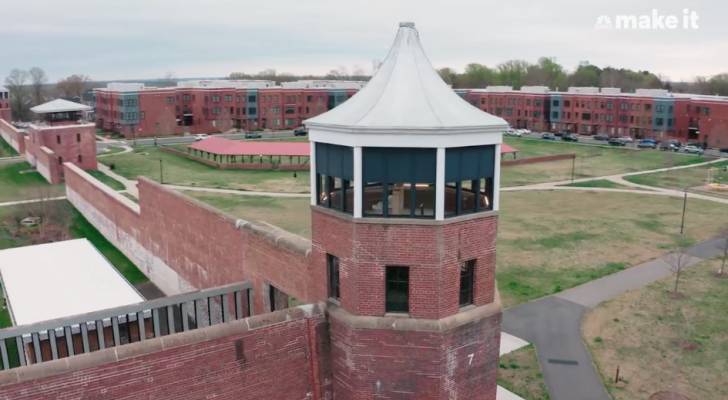
Would you choose to live in a prison? You might — if it had been converted into a community of well-designed apartments with a club house, swimming pool, green spaces, restaurants, retail shops and even a preschool.
That’s exactly what was done to an old prison in Lorton, Virginia.
Don’t miss
- I’m 49 years old and have nothing saved for retirement — what should I do? Don’t panic. Here are 5 of the easiest ways you can catch up (and fast)
- Gain potential quarterly income through this $1B private real estate fund — even if you’re not a millionaire. Here’s how to get started with as little as $10
- You’re probably already overpaying for this 1 ‘must-have’ expense — and thanks to Trump’s tariffs, your monthly bill could soar even higher. Here’s how 2 minutes can protect your wallet right now
“We really felt that we were liberating these buildings from its dark past, and for that reason we thought Liberty was a good name for the project,” David Vos, a development project manager with real estate developer The Alexander Company, told CNBC Make It.
From abandoned prison to designer apartments
The Lorton Reformatory prison complex, originally commissioned by Theodore Roosevelt, was built in 1910 and shuttered in 2001. In 2002, Fairfax County bought the 2,324-acre campus for $4.2 million.
In 2008, The Alexander Company — which specializes in urban infill development and historic preservation — partnered with the county and Elm Street Development to help convert the campus, with renovations taking place from 2015 to 2017.
The company spent $64 million converting 207,000 square feet into the Liberty Crest Apartments. Rent for the 165 apartments ranges from $1,372 and $2,700 per month. For comparison, the average rent for all property types in Virginia is $1,700 per month.
Forty-four of the units are set aside for people earning 50% of the median household income of $136,719 for Lorton, according to CNBC Make It. These units were fully leased within a couple of months and have been at full occupancy since.
The Lorton Reformatory was a Progressive Era prison, so it’s architecturally interesting and laid out well for apartments, with plenty of windows providing lots of natural light and ventilation.
The original dining room has been turned into a club house with a pool table and shuffleboard table, while the prison ball field has been converted to a central green for residents. There’s also a fitness center, yoga room, swimming pool and two playground areas, along with retail shops and restaurants.
Plus, there’s still room for development. A few penitentiary buildings on the complex are slated to become commercial spaces and the power plant is being converted into 10 additional apartments.
The developers, believing we can learn from our past, have kept some signage from the original prison intact as a reminder of what the buildings once were.
Read more: Want an extra $1,300,000 when you retire? Dave Ramsey says this 7-step plan ‘works every single time’ to kill debt, get rich in America — and that ‘anyone’ can do it
The economic and environmental promise of adaptive reuse
The Liberty Crest Apartments are a prime example of adaptive reuse — when existing assets in a built area are repurposed for new uses. This can be an environmentally friendly way to develop needed spaces such as affordable housing.
According to The World Economic Forum (WEF), “cities are turning to adaptive reuse as a powerful strategy to reduce waste, cut emissions and enhance circular economy principles in the built environment.”
Repurposing an existing building emits 50% to 75% less carbon than building new, according to WEF, and the process itself can be efficient — up to 90% of materials can be salvaged and diverted from landfills when buildings are repurposed rather than demolished. By saving the expense of demolition and new construction, repurposing can result in cost savings of 12% to 15%.
Communities also benefit from adaptive reuse because it helps to preserve culture and architecture while creating unique, distinctive spaces to work and live. It can also be a catalyst for urban renewal and innovation.
For example, where the Lorton prison complex was once an empty, decaying structure, there’s now attractive architecture, affordable housing and community spaces.
Adaptive reuse projects can also boost property values in the surrounding community through neighborhood revitalization. Jobs are created during the project and, longer term, for ongoing maintenance and administration of the new facility — as well as through any commercial spaces that may be part of the development.
However, it often means overcoming community and regulatory hurdles. In the case of Lorton Reformatory, investors initially expressed concern that the development was in a metro area without mass transit and that mixed-income housing might turn off prospective developers. Eventually, an investor did see the potential — and the result is Liberty Crest Apartments.
Despite these types of hurdles, adaptive reuse projects represent a huge opportunity for developers and communities alike. CNBC Make It reports that 188 prison facilities were shut down in the U.S. between 2000 and 2022, and in at least nine states conversions of these facilities are either underway or have been completed.
After all, why would communities and developers want to keep that much potential locked up?
What to read next
- Millions of Americans now sit on a stunning $35 trillion in home equity — here’s 1 new way to invest in responsible US homeowners while targeting a 14%-17% IRR
- Robert Kiyosaki warns of a ‘Greater Depression’ coming to the US — with millions of Americans going poor. But he says these 2 ‘easy-money’ assets will bring in ‘great wealth’. How to get in now
- Here are 5 ‘must have’ items that Americans (almost) always overpay for — and very quickly regret. How many are hurting you?
This article provides information only and should not be construed as advice. It is provided without warranty of any kind.


